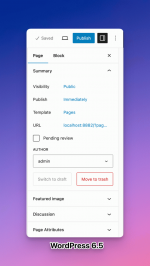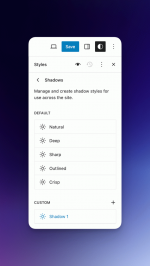A few times a year, the WordPress open source software gets a major update, providing users with new capabilities, regular refinements, and important bug fixes. With hundreds of fixes and enhancements, WordPress 6.6 brings a new level of creativity, usability, and efficiency to your WordPressing.
Here’s a quick tour of what this latest update offers folks on WordPress.com, starting with some of the basics about WordPress 6.6.
Table of Contents
- The basics
- More efficient views and navigation in the Site Editor
- Unified and updated publishing flow
- Override synced patterns with custom content
- Automatic plugin rollbacks
- New design elements
- Section-specific styles
- Block Bindings API upgrades
- And more!
WordPress 6.6 is available right now and has likely already landed on your WordPress.com site. You may notice that many of these new features have been available on your site(s) for a few weeks or even months; we often roll out updates in waves on WordPress.com to allow for early access, testing, and iteration before these major updates are more widely released.
Sites on WordPress.com are updated automatically. If you run into issues or bugs, always feel free to reach out to our expert Happiness Engineers at wordpress.com/help.
The last couple major WordPress releases have dramatically reimagined the Site Editor experience. With 6.6 you’ll see a new side-by-side default layout when viewing and editing pages.
Pattern management has also been better integrated, ensuring more efficient navigation and fewer clicks to get where you want to be.
Amidst these bigger changes are a number of small enhancements to keyboard navigation, bulk editing actions, and the overall design and functionality of the Site Editor.
Unified and updated publishing flow

If you’ve spent time in the Site Editor, you’ll have noticed that it used to offer a fairly different experience from the page/post editor. WordPress 6.6 now offers a shared workflow for publishing, leading to smoother interactions when navigating between various elements of your site.
As part of this unification, there’s also an update to the layout and design of the publish flow with more prominent displays for the title, publishing status, and featured image.
For all the plugin and theme developers out there, this particular update also makes it easier to extend the editor. Both the post/page editor and Site Editor now use the same slots and extensibility APIs.
For users, this means a lot more plugins will be able to bring exciting features into the editor. For plugin developers, it means that it’s easier to implement your code to extend the editor’s capabilities.
Override synced patterns with custom contentThis new feature allows for editing specific blocks even when you’re utilizing synced patterns and styles. For example, if you have a pattern for a stylized button CTA, you can use this override feature to use different copy or even colors for different pages and button locations, while maintaining common elements.
You can “Enable Overrides” from the “Advanced” section of the Paragraph, Heading, Buttons, and Image blocks, with more block support planned for the future.
Automatic plugin rollbacksWhen it comes to plugin management, WordPress.com offers unparalleled reliability and redundancy. In addition to the scheduled plugin updates that we recently introduced, WordPress core now offers automatic rollbacks when a plugin update fails.
If you don’t utilize scheduled updates, your plugins will update automatically when new versions become available.
In the past, if a plugin update failed, WordPress would leave the plugin inactive, which might render some parts of your website unusable or broken. In WordPress 6.6, the plugin is rolled back to the previous version, ensuring continuity with your site until you can diagnose and fix the issue.
New design elementsWordPress 6.6 offers a handful of new customization options for designing and stylizing your site. Let’s explore the most impactful new features.
Site background image
Make an immediate visual splash with the new site-wide background image option in the Site Editor. Whether it’s a striking full-bleed photo or a whimsical graphic pattern, you have the freedom to choose size, position, and repetition.
Negative marginsYou can now set negative margins for any block, allowing for more granular margin control. This enables users to more easily create overlapping design elements. Note that negative values must be entered manually rather than with the slider.
All-new grid supportWith the Grid and Grid Layout blocks, you can quickly create professional-looking grids for your images, testimonials, videos, and more. The “Auto” option automatically generates mobile-responsive rows and columns while the “Manual” option provides more granular control.
Custom default shadow styles
From the Styles menu, you can now edit shadow effects, including changing the default shadow style for images, buttons, and more. You can also add your own shadow styles, giving your total control over this subtle and powerful design element.
Section-specific stylesHere’s one for the theme builders out there. With WordPress 6.6, you have the option to define style variations for specific sections of a site, not just the theme as a whole. To enable this, you’ll have to edit your theme’s theme.json file and declare the style variation (click here for instructions). Once that’s set up, you will be able to quickly modify the styles of several blocks for areas like headers, footers, content sections, and more.
As a bonus, section styles also work flawlessly with content imported from our public pattern collection.
Block Bindings API upgradesThis release makes Block Bindings easier to use and more powerful. Originally available since WordPress 6.5, this feature allows users to connect (or “bind”) the content of a block to the data of a custom field. Here’s how to create that in a post. WordPress 6.6 takes it one step further by enabling the option to edit custom field data by just updating the block in the editor.
And more!There are hundreds of updates to WordPress in the 6.6 release. What we’ve highlighted above is a just taste of the most notable and visible features. If you’re a developer and want to look under the hood a bit more, you can find the full slate of goodies in this WordPress 6.6 Field Guide.
Click below if you’re a developer and want to leverage the benefits of hosting your sites with WordPress.com:
Learn more*Photo and video credit: WordPress.org







